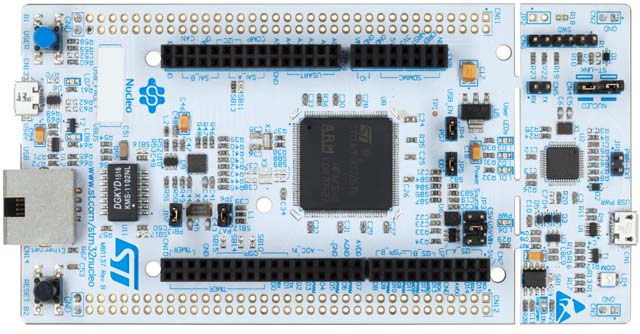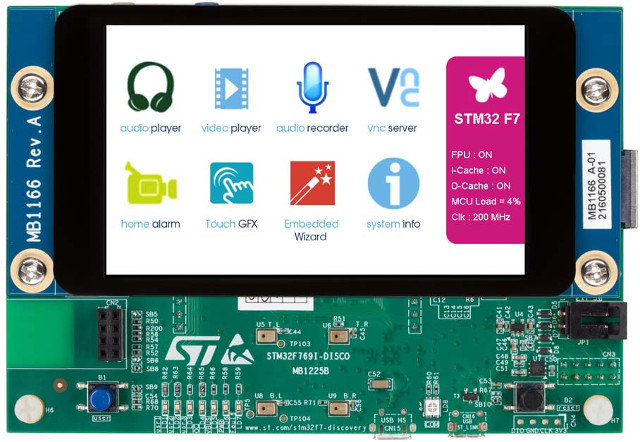STMicroelectronics introduiced its STM32F7 ARM Cortex M7 micro-controller family in 2014, and they released a $49 STM32F746G discovery board later in 2015. The company has now launched two new low cost development boards with the $23 STM32 Nucleo-144 board based on STM32F767 MCU, and a $79 Discovery Kit powered by STM32F746 MCU with TFT-LCD and MIPI-DSI support.
STM32 Nucleo-144 development board
 Key feature of NUCLEO-F767ZI board:
Key feature of NUCLEO-F767ZI board:
- MCU – STMicro STM32F767ZI ARM Cortex M7 microcontroller @ 216 MHz with FPU, DSP, MMU, 2MB flash, 512 KB SRAM, 16 KB instruction TCM RAM (for critical real-time routines), and 4 KB backup SRAM
- Connectivity – IEEE-802.3-2002 compliant Ethernet connector
- USB – 1x micro USB OTG or full speed device
- Extension:
- ST Zio connector including support for Arduino UNO v3 connectivity, and additional signals (A6 to A8, D16 to D72)
- ST morpho extension pin header footprints for full access to all STM32 I/Os
- On-board ST-LINK/V2-1 debugger/programmer with SWD connector
- Misc – 3x user LEDs; USER & RESET push-buttons; 32.768 KHz crystal oscillator
- Power supply
- 5V from ST-LINK/V2-1 USB VBUS
- External power sources: 3.3 V and 7 – 12 V on ST Zio or ST morpho connectors, 5 V on ST morpho connector
The board is ARM mbed enabled, the company provides free software HAL library & software examples, and the development board is also supported by tools such as IAR, Keil, and GCC-based IDEs.
Hardware and software documentation, as well as links to distributors can be found on the product page.
32F746G-DISCOVERY Board
Key features of STM32F769I-DISCO board:
- MCU – STMicro STM32F769NIH6 ARM Cortex-M7 microcontroller @ 216 MHz with FPU, DSP, MMU, 2MB Flash, 512 KB SRAM, 16 KB instruction TCM RAM (for critical real-time routines), and 4 KB backup SRAM
- External Memory – 128-Mbit SDRAM
- External Storage – micro SD slot, 512-Mbit Quad-SPI Flash memory
- Display – 4″ capacitive touch LCD display with MIPI DSI connector
- Connectivity – Ethernet connector compliant with IEEE-802.3-2002, WI-FI or Ext-EEP daughterboard connector
- Audio
- SAI audio codec
- 2x audio line jacks, one for input and one for output
- Stereo speaker outputs
- 4x ST MEMS microphones on DFSDM inputs
- 2x S/PDIF RCA input and output connectors
- USB – 1x micro USB OTG port
- On-board ST-LINK/V2-1 supporting USB reenumeration capability
- Expansion – Arduino UNO v3 headers
- Misc – 2x push buttons (user and reset)
- Power supply:
- ST LINK/V2-1
- USB HS connector
- 5 V from RJ45 (Power Over Ethernet)
- 5 V from Arduino or external connector
- USB charger
- Power Over Ethernet based on IEEE 802.3af (Powered Device, 48V to 5V, 3W)
- Power supply output for external applications: 3.3 V or 5 V

The company provide libraries and examples part of the STM32Cube package, and the board is also supported by various integrated development environments: Keil MDK-ARM, IAR EWARM, and GCC-based IDEs (free AC6: SW4STM32, Atollic TrueSTUDIO, …) allowing development in Linux or Windows operating systems. Like other STMicro boards, STM32F769I-DISCO board is open source hardware, and you can find the hardware design files, as well as software document on the product page, where you’ll also find links to purchase the board.
The company also announced two higher end STM32F7 boards selling for $360: STM32F769I-EVAL & STM32F779I-EVAL.

Jean-Luc started CNX Software in 2010 as a part-time endeavor, before quitting his job as a software engineering manager, and starting to write daily news, and reviews full time later in 2011.
Support CNX Software! Donate via cryptocurrencies, become a Patron on Patreon, or purchase goods on Amazon or Aliexpress






The chip does not have MMU, it has MPU instead. Sadly, there are no Cortex-M with fully featured MMU.